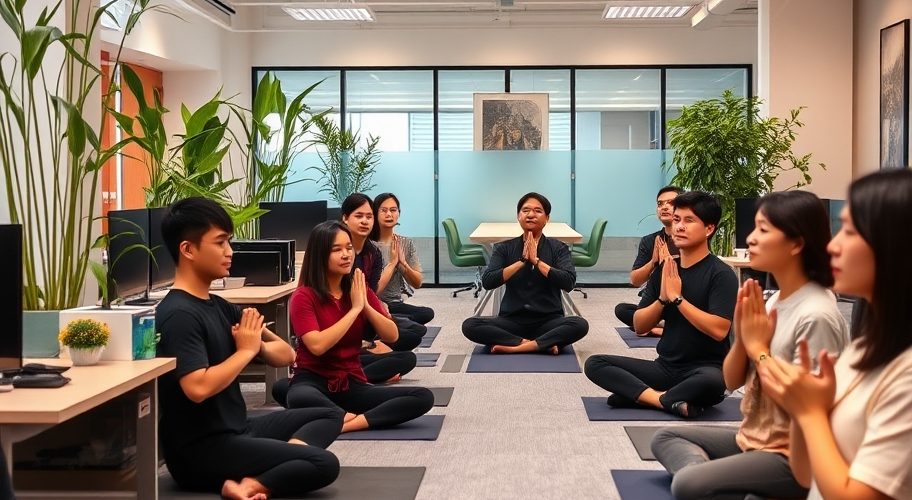Community Yoga: A Path to Stress Management and Enhanced Productivity in Corporate Settings
- February 8, 2025
- Posted by: admin
- Category: Articles by Practitioners,

By Joti Chugani
In the fast-paced, high-pressure environment of modern corporate life, stress has become an inevitable companion for many professionals. As deadlines loom, expectations rise, and demands increase, employees often find themselves on the verge of burnout. These pressures can decrease morale, disrupt productivity, and even lead to physical and mental health challenges. In response to these growing concerns, organisations are searching for effective solutions that promote wellness, reduce stress, and enhance workplace culture. One powerful tool gaining popularity is community yoga, which not only addresses stress but fosters a more balanced and productive work environment.
This article explores the impact of yoga on employee wellness and productivity, including practical strategies to integrate it into corporate activities. With a focus on corporate employees, HR professionals, and yoga practitioners, community yoga is a holistic solution that benefits both individuals and organisations.
The Benefits of Yoga for Stress Management
Yoga offers a blend of physical postures, breathing exercises, and mindfulness techniques that promote mental clarity, emotional resilience, and physical well-being. According to research, yoga is an effective stress-management tool, as it helps lower cortisol levels (the stress hormone), improve mood, and enhance overall well-being.
Stress Reduction
One of the primary benefits of yoga is its ability to mitigate stress by balancing the nervous system. When employees practice mindfulness and breathing exercises, they activate the parasympathetic nervous system, which reduces anxiety and promotes relaxation. Studies published in ScienceDirect confirm that yoga’s stress-reducing effects can also alleviate symptoms of depression and help maintain emotional stability, especially in high-pressure corporate environments.

Improved Focus and Concentration
Yoga does not just help manage stress; it also boosts cognitive function. Regular yoga practice enhances memory retention, mental clarity, and concentration, which are essential in a dynamic workplace. A review in PubMed Central found that workplace yoga interventions reduced perceived stress levels among employees, leading to improved decision-making and higher productivity.

Physical Well-Being
Prolonged sitting, repetitive tasks, and hours spent hunched over a computer can wreak havoc on the body. Yoga counters these physical strains by promoting better posture, increasing flexibility, and strengthening muscles. Employees who integrate yoga into their routines experience relief from back pain and muscle stiffness, leading to a healthier, more active lifestyle.

Emotional Balance
Yoga not only helps balance emotions but also builds emotional resilience, empowering employees to handle workplace challenges more effectively. Regular yoga practitioners report increased positivity, better interpersonal interactions, and a stronger sense of community in the workplace. Research from Clockwise indicates that yoga reduces cortisol levels and enhances the ability to reinterpret stressful situations, leading to a more harmonious work culture.

Integrating Yoga into Corporate Activities
For yoga to become a sustainable part of workplace culture, HR professionals and leaders must actively create opportunities for participation. Here are a few strategies to seamlessly integrate yoga into corporate life:
- Yoga Breaks
Short yoga breaks throughout the workday allow employees to recharge without compromising productivity. Designating quiet spaces where employees can engage in breathing exercises, stretches, or short meditations helps maintain a balanced atmosphere in the office.
- Team Challenges
Yoga team challenges offer a fun way to foster camaraderie. Encourage employees to work together to achieve specific yoga poses or sequences, building teamwork and reducing stress in the process.
- Training Programmes
Incorporating yoga into employee onboarding and training sessions ensures that employees have the tools to manage stress from the start of their careers. Offering mindfulness workshops and simple yoga practices for new hires can set a tone of well-being and balance in the workplace.
- Virtual Classes
For remote or hybrid teams, offering virtual yoga classes enables all employees to access wellness programmes regardless of their location. Recorded sessions can also provide flexibility, allowing employees to participate when it fits their schedule.
Office-Friendly Yoga Poses
To make yoga more accessible, here are some simple yet effective poses that can be easily incorporated into the workday:
- Seated Forward Bend: This pose stretches the back and relieves tension in the lower spine, making it ideal for employees who spend long hours sitting at a desk.
- Neck Rolls: Relieve neck and shoulder tension with gentle rolls in both directions.
- Wrist Stretches: Flex the wrists to alleviate the strain from typing.
- Chair Pose: A standing pose that strengthens the legs and core, promoting balance and focus.
- Cat-Cow Stretch: A seated variation of the traditional yoga pose that helps improve spinal mobility.
- Standing Side Stretch: Open up the ribcage and promote deep breathing by stretching the side body.
- Seated Spinal Twist: Improve spinal flexibility by twisting gently to both sides.

Culmination: The Path to a Balanced Workplace
Incorporating community yoga into corporate wellness programmes offers a powerful way to manage stress, promote physical health, and improve productivity. Research consistently supports the positive impact of yoga on employee well-being, leading to higher job satisfaction, lower turnover, and improved team collaboration. By prioritising wellness initiatives, organisations can cultivate an environment where employees feel valued, supported, and empowered to bring their best selves to work.
As the future of work evolves, community yoga stands out as a simple, yet transformative practice that can help employees thrive both personally and professionally. HR professionals have the opportunity to implement yoga programmes that foster balance, enhance morale, and create lasting positive change within the workplace.
References:
- Pascoe, M. C., & Bauer, I. E. (2015). A systematic review of randomised control trials on the effects of yoga on stress measures and mood. *Journal of Psychiatric Research, 68*, 270-282. https://doi.org/10.1016/j.jpsychires.2015.07.013
- Sharma, A., Madaan, V., & Petty, F. D. (2006). Exercise for mental health. *Primary Care Companion to the Journal of Clinical Psychiatry, 8*(2), 106. https://doi.org/10.4088/pcc.v08n0208a
- Cramer, H., Lauche, R., Haller, H., & Dobos, G. (2013). A systematic review and meta-analysis of yoga for low back pain. *The Clinical Journal of Pain, 29*(5), 450-460. htttps://doi.org/10.1097/AJP.0b013e31825e1492
- Goyal, M., Singh, S., Sibinga, E. M., Gould, N. F., Rowland-Seymour, A., Sharma, R., … & Ranasinghe, P. D. (2014). Meditation programmes for psychological stress and well-being: a systematic review and meta-analysis. *JAMA Internal Medicine, 174*(3), 357-368. https://doi.org/10.1001/jamainternmed.2013.13018
